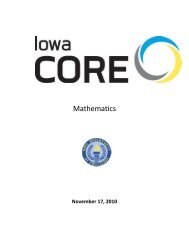The Arc's Self-Determination Scale: Procedural Guidelines
The Arc's Self-Determination Scale: Procedural Guidelines
The Arc's Self-Determination Scale: Procedural Guidelines
Create successful ePaper yourself
Turn your PDF publications into a flip-book with our unique Google optimized e-Paper software.
<strong>The</strong> Arc, he said: “Unlike the staff at the institution, the human<br />
services professionals I met at this job treated me with respect.<br />
<strong>The</strong>y gave me a chance to contribute my input and feedback and<br />
believed in many of my ideas. My colleagues also adapted the<br />
working environment to help me communicate with them” (Gagne,<br />
1994, p. 333).<br />
<strong>The</strong> movement to support and promote self-determination is<br />
about treating people with dignity and respect. It is about enabling<br />
people with disabilities to achieve independence, integration and<br />
inclusion to the greatest extent possible by providing them the<br />
opportunities to learn the skills they need and the chance to put<br />
those skills into action. It is about empowerment, choice and<br />
control. One critical aspect of empowerment is the equitable<br />
distribution of valued, and often scarce, resources, like jobs,<br />
financial security and health care. People with disabilities<br />
continue to experience social isolation, segregation, un- and underemployment,<br />
and discrimination. It is critical to provide greater<br />
opportunities for inclusion and choice, employment, home<br />
ownership and social integration. A key factor to achieving this is<br />
achieving the outcome that adults with disabilities are selfdetermined.<br />
Gagne (1994) makes the same point when he<br />
summarized his life experiences:<br />
“I wrote this story to let people know what it was like<br />
growing up in an institution from the 1950’s through the<br />
1970’s. <strong>The</strong> total lack of power in making decisions about<br />
my life made me angry, and I was treated as an outcast.<br />
<strong>The</strong> staff’s abuse, neglect, and insensitivity kept me from<br />
being educated and learning the other basic skills that many<br />
children learn from caring adults. When I got into the real<br />
world, I wasn’t sure what my role was. Nobody ever talked<br />
to me or taught me how to be successful. I learned to<br />
survive mostly on my own and with the help of a few good<br />
people.<br />
I feel that what happened to me should never<br />
happen again” (p. 334).<br />
<strong>Self</strong>-<strong>Determination</strong> and Youth with Mental Retardation<br />
Many people presume that the presence of a significant cognitive<br />
or intellectual impairment precludes, a priori, an individual from<br />
becoming competent. <strong>The</strong> terms "self-determined" and "severe<br />
disability" are usually viewed as mutually exclusive. <strong>The</strong> presence<br />
of a severe cognitive disability is more likely to evoke assumptions<br />
of incompetent decision-making, protectionism, legal<br />
guardianship, and vulnerability than competency, effective<br />
48
















